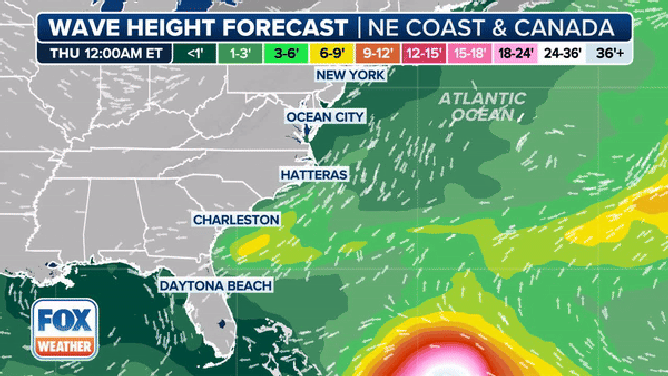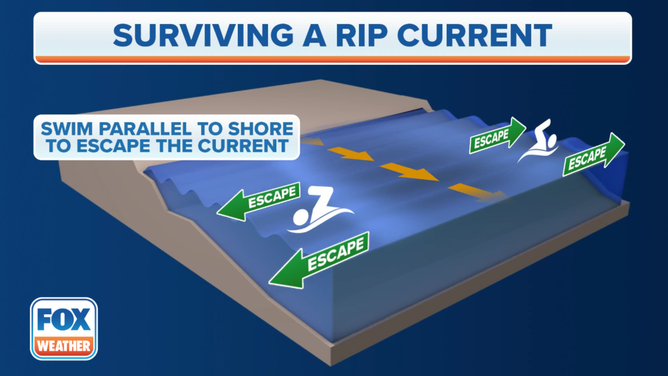Some East Coast beaches closed to swimmers as Hurricane Ernesto churns offshore
NOAA data as of Aug. 4 shows that 30 people have died due to rip currents or rough surf in the U.S. this year. Most fatalities occurred in Florida, but beaches in Puerto Rico and the Carolinas have seen significant events.
Ernesto pounding US East Coast despite being hundreds of miles away
Dangerous waves and rip currents generated by Hurricane Ernesto are lashing the East Coast of the U.S. despite the storm being hundreds of miles away from the mainland. Harry Harsin, chief Lifeguard of Belmar Beach in New Jersey, talks about how to protect yourself from rip currents.
Even with Hurricane Ernesto passing several hundred miles off the U.S. East Coast, beaches from Florida to Maine saw impacts from the powerful storm.
The threat for rip currents was considered to be high and waves reached several feet high, causing some beaches in North Carolina, New York and Massachusetts to temporarily ban swimming.
Ernesto formed in the Atlantic Ocean on Monday before impacting the Caribbean islands with tropical storm conditions and made landfall in Bermuda as a Category 1 hurricane on Saturday.
Significant troughing off the East Coast acted as a barrier, keeping the hurricane from making a direct strike on the U.S.
WATCH: HURRICANE ERNESTO'S SWELL CAUSES NORTH CAROLINA HOUSE TO COLLAPSE INTO OCEAN

(FOX Weather)
The swell produced by Hurricane Ernesto even led to at least one house collapsing along North Carolina’s Outer Banks on Friday,
Local Emergency Management reported the house was unoccupied and was already at risk of collapsing well before the hurricane’s tides did in the weakened structure.
And at least two people died during rip current-related incidents, according to authorities in South Carolina.
The surf threat was considered significant enough that the National Hurricane Center is warning about the dangers in its advisories.
"Swells generated by Ernesto are affecting portions of the Bahamas, Bermuda, and the east coast of the United States and will reach portions of Atlantic Canada today. Life-threatening surf and rip current conditions are likely in these areas during the next couple of days. Please consult products from your local weather office, and stay out of the water if advised by lifeguards," NHC forecasters stated.
High water levels are expected to continue for several days as the U.S. East Coast not only sees increased swells from Ernesto but also August’s full supermoon.

Expected wave height forecast.
(FOX Weather)
Rip currents form when water piles up, creating a narrow, fast-flowing stream that swiftly carries swimmers away from shore, often catching them off guard. These currents can move at speeds of up to 8 feet per second.
Tropical cyclones such as Beryl and Debby earlier in the season caused an increase in rip currents along parts of the U.S. coastline, but no fatalities have been tied to the events.

Swimmers are advised to swim parallel to the shoreline if caught in a rip current.
(FOX Weather)
Dozens have perished in rough waters during 2024
As of Aug. 4, at least 30 people have died due to rip currents or rough surf around the country, according to NOAA data.
Most fatalities have occurred in Florida, but beaches in Puerto Rico and the Carolinas have seen significant events.
During most events where a fatality was caused by surf, lifeguards flew a single red flag, which means swimming is discouraged due to dangerous conditions.
Many lifeguard organizations use colored flags as a way to alert beachgoers to the ever-changing ocean conditions.
A green flag indicates a low threat of hazardous conditions, while a double red flag means the water is closed to the public.
A significant increase in rip currents usually results in a single red flag being hoisted at beaches, but conditions can vary depending on a region’s topography.
